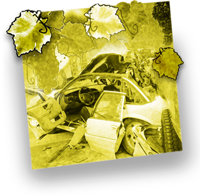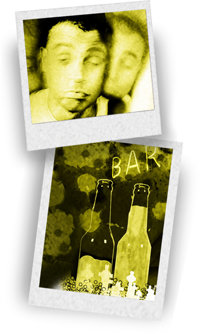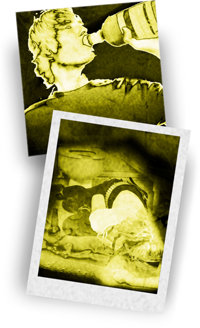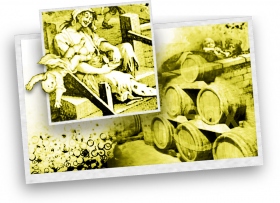Alcohol is a drug.
It is classed as a depressant, meaning that it slows down vital functions—resulting in slurred speech, unsteady movement, disturbed perceptions and an inability to react quickly.
As for how it affects the mind, it is best understood as a drug that reduces a person’s ability to think rationally and distorts his or her judgment.
Although classified as a depressant, the amount of alcohol consumed determines the type of effect. Most people drink for thestimulant effect, such as a beer or glass of wine taken to “loosen up.” But if a person consumes more than the body can handle, they then experience alcohol’s depressant effect. They start to feel “stupid” or lose coordination and control.
Alcohol overdose causes even more severe depressant effects (inability to feel pain, toxicity where the body vomits the poison, and finally unconsciousness or, worse, coma or death from severe toxic overdose). These reactions depend on how much is consumed and how quickly.
There are different kinds of alcohol. Ethyl alcohol (ethanol), the only alcohol used in beverages, is produced by the fermentation of grains and fruits. Fermenting is a chemical process whereby yeast acts upon certain ingredients in the food, creating alcohol.
ALCOHOL CONTENT
Fermented drinks, such as beer and wine, contain from 2% alcohol to 20% alcohol. Distilled drinks, or liquor, contain from 40% to 50% or more alcohol. The usual alcohol content for each is:
DRINKING AND DRIVING
- In the United States in 2007, the death toll from teenage
drunk-driving accidents was 1,393—nearly four fatalities every day of the year.
- Motor vehicle accidents are the leading cause of death among teenagers in the US and are responsible for more than one in three deaths of American teenagers. Of the teen drivers killed on the road in 2006, 31% had been drinking, according to the National Highway Traffic Safety Administration.
For most people, these are only statistics—shocking, perhaps, but only statistics. But for the families and friends of those who die as a result of teenage drinking and driving, each number represents a tragic loss.
Alcohol distorts a person’s perceptions and judgment. People under the influence of alcohol readily admit their reaction time is slower than when not drinking, and they take many chances they would never take when sober. Too often those chances are fatal.
Alcohol is absorbed into the bloodstream via small blood vessels in the walls of the stomach and small intestine. Within minutes of drinking alcohol, it travels from the stomach to the brain, where it quickly produces its effects, slowing the action of nerve cells.
Approximately 20% of alcohol is absorbed through the stomach. Most of the remaining 80% is absorbed through the small intestine.
Alcohol is also carried by the bloodstream to the liver, which eliminates the alcohol from the blood through a process called “metabolizing,” where it is converted to a nontoxic substance. The liver can only metabolize a certain amount at a time, leaving the excess circulating throughout the body. Thus the intensity of the effect on the body is directly related to the amount consumed.
When the amount of alcohol in the blood exceeds a certain level, the respiratory (breathing) system slows down markedly, and can cause a coma or death, because oxygen no longer reaches the brain.
YOUNG PEOPLE VERSUS ADULTS. WHAT'S THE DIFFERENCE?
A young person’s body cannot cope with alcohol the same way an adult’s can.
Drinking is more harmful to teens than adults because their brains are still developing throughout adolescence and well into young adulthood. Drinking during this critical growth period can lead to lifelong damage in brain function, particularly as it relates to memory, motor skills (ability to move) and coordination.
According to research, young people who begin drinking before age 15 are four times more likely to develop alcohol dependence than those who begin drinking at age 21.
For some teens, like Samantha, drinking seems to be a solution to problems they don’t want to face.
“When I was 13, friends would make fun of me if I didn’t have a drink. I just gave in because it was easier to join the crowd. I was really unhappy and just drank to escape my life.
“I went out less and less so started losing friends and the more lonely I got, the more I drank.
“I was violent and out of control. I never knew what I was doing. I was ripping my family apart.”
Kicked out of her home at age 16, she was homeless and started begging for money to buy drinks. After years of abuse, doctors told her there was irreparable harm to her health.
“...I was only 16 but my liver was badly damaged and I was close to killing myself from everything I was drinking.” —Samantha
WHAT IS ALCOHOLISM OR ALCOHOL DEPENDENCE?
- Craving: a strong need, or compulsion, to drink.
- Loss of control: the inability to limit one’s drinking on any given occasion.
- Physical dependence: withdrawal symptoms, such as nausea, sweating, shakiness and anxiety, occur when alcohol use is stopped after a period of heavy drinking.
Serious dependence can lead to life-threatening withdrawal symptoms including convulsions, starting eight to twelve hours after the last drink. The delirium tremens (D.T.’s) begins three to four days later where the person becomes extremely agitated, shakes, hallucinates and loses touch with reality.
- Tolerance: the need to drink greater amounts of alcohol in order to get high.
An increasingly heavy drinker often says he could stop whenever he chooses—he just never “chooses” to do so. Alcoholism is not a destination, but a progression, a long road of deterioration in which life continuously worsens.
“When I went to quit drinking, I realized that alcohol had taken to my body in such a way that I couldn’t stop. I would shake like I was going to break, I would start to sweat, I couldn’t think until I had another drink. I couldn’t function without it.
“I spent the next 8 years in and out of detox and hospitals, trying to figure out what happened to me, how was it possible I couldn’t quit. It was the worst and longest nightmare.” —Jan
INTERNATIONAL STATISTICS
Alcohol kills more teenagers than all other drugs combined. It is a factor in the three leading causes of death among 15- to 24-year-olds: accidents, homicides and suicides.
- Youth who drink are 7.5 times more likely to use other illegal drugs and fifty times more likely to use cocaine than young people who never drink. One survey found that 32% of the heavy drinkers over 12 were also illegal drug users.
- In 2005, 6.6% of the US population aged 12 or older, or 16 million people, reported heavy drinking (binge drinking on at least five days of the past thirty days).
- Of the 3.9 million Americans who received treatment for a substance abuse problem in 2005, 2.5 million of them were treated for alcohol use.
- Alcohol-related traffic deaths in the US were 12,998 in 2007. This is more than three times as many American soldiers who died in combat in the first six years of the Iraq war.
- There are 1.4 million drunk driving arrests in the US every year.
- A US Department of Justice study found that as many as 40% of violent crimes occur under the influence of alcohol.
- In 2005–2006, there were 187,640 National Health System alcohol-related hospital admissions in England.
- There were 6,570 deaths in England in 2005 from causes directly linked to alcohol use. In 2006, alcohol-related deaths in England rose to 8,758. This amounts to an annual increase of 7% from the previous year.
- According to one study, of the 490 million people in the European Union, more than 23 million are dependent on alcohol.
- In Europe, alcohol contributes to nearly one in ten of all cases of illness and premature deaths each year.
- 39% of all traffic deaths involved alcohol in 2005.
- 40% of violent crimes occur under the influence of alcohol.
SHORT-TERM EFFECTS OF ALCOHOL
Depending on how much is taken and the physical condition of the individual, alcohol can cause:
- Slurred speech
- Drowsiness
- Vomiting
- Diarrhea
- Upset stomach
- Headaches
- Breathing difficulties
- Distorted vision and hearing
- Impaired judgment
- Decreased perception and coordination
- Unconsciousness
- Anemia (loss of red blood cells)
- Coma
- Blackouts (memory lapses, where the drinker cannot remember events that occurred while under the influence)
LONG-TERM EFFECTS OF ALCOHOL
Binge drinking and continued alcohol use in large amounts are associated with many health problems, including:
- Unintentional injuries such as car crash, falls, burns, drowning
- Intentional injuries such as firearm injuries, sexual assault, domestic violence
- Increased on-the-job injuries and loss of productivity
- Increased family problems, broken relationships
- Alcohol poisoning
- High blood pressure, stroke, and other heart-related diseases
- Liver disease
- Nerve damage
- Sexual problems
- Permanent damage to the brain
- Vitamin B1 deficiency, which can lead to a disorder characterized by amnesia, apathy and disorientation
- Ulcers
- Gastritis (inflammation of stomach walls)
- Malnutrition
- Cancer of the mouth and throat
“My addiction built steadily and, before I realized it, I had become a morning as well as an afternoon drinker.
“I decided to stop drinking. I lay awake most of that night, and by noon the next day every bone in my body ached. In a blind panic, I nervously poured a glass full of gin, my hands shaking so violently that I spilled half the bottle. As I gulped it down, I could feel the agony gradually lessening. Then I finally knew the terrible truth: I was hooked. I couldn’t quit.”—Faye
THE YOUNGEST VICTIMS
When consumed by pregnant mothers, alcohol enters the bloodstream, passes through the placenta and enters the fetus (unborn child).
Alcohol can damage a fetus at any stage of pregnancy, but is most serious in the first few months. There is a risk of alcohol-related birth defects including growth deficiencies, facial abnormalities, and damage to the brain and nervous system.
Alcohol has claimed the lives of many gifted artists, musicians and writers over the past decades. These are just a few:
John Bonham (1948–1980): Excessive alcohol led to the tragic death of Led Zeppelin drummer John “Bonzo” Bonham, best known for his drum solo on the song “Moby Dick.” He was found dead of asphyxiation from vomit after a night of heavy drinking, on his way to rehearsals for an upcoming tour.
Steve Clark (1960–1991): Guitarist for Def Leppard. A heavy drinker, he died in his London home of a lethal combination of alcohol and drugs.
Michael Clarke (1946–1993): American musician, drummer for The Byrds. He died of liver failure after three decades of heavy alcohol consumption.
Brian Connolly (1945–1997): Scottish rock vocalist and lead singer for Sweet. His drinking problem caused him to leave the band in 1978; he reunited years later but his drinking had damaged his health and he died of liver failure in 1997.
Oliver Reed (1938–1999): British actor known for his roles in Oliver!, Women in Love, TheThree Musketeers and Gladiator. He died from a sudden heart attack during a break from filming Gladiator. He was heavily intoxicated after 3 bottles of rum, 8 bottles of beer and numerous doubles of whiskey.
ALCOHOL: A SHORT HISTORY
Fermented grain, fruit juice and honey have been used to make alcohol (ethyl alcohol or ethanol) for thousands of years.
Fermented beverages existed in early Egyptian civilization, and there is evidence of an early alcoholic drink in China around 7000 B.C. In India, an alcoholic beverage called sura, distilled from rice, was in use between 3000 and 2000 B.C.
The Babylonians worshiped a wine goddess as early as 2700 B.C. In Greece, one of the first alcoholic beverages to gain popularity was mead, a fermented drink made from honey and water. Greek literature is full of warnings against excessive drinking.
Several Native American civilizations developed alcoholic beverages in pre-Columbian1 times. A variety of fermented beverages from the Andes region of South America were created from corn, grapes or apples, called “chicha.”
In the sixteenth century, alcohol (called “spirits”) was used largely for medicinal purposes. At the beginning of the eighteenth century, the British parliament passed a law encouraging the use of grain for distilling spirits. Cheap spirits flooded the market and reached a peak in the mid-eighteenth century. In Britain, gin consumption reached 18 million gallons and alcoholism became widespread.
The nineteenth century brought a change in attitudes and the temperance movement began promoting the moderate use of alcohol—which ultimately became a push for total prohibition.
In 1920 the US passed a law prohibiting the manufacture, sale, import and export of intoxicating liquors. The illegal alcohol trade boomed and by 1933, the prohibition of alcohol was cancelled.
Today, an estimated 15 million Americans suffer from alcoholism and 40% of all car accident deaths in the US involve alcohol.
- 1.pre-Columbian: before the arrival in America of Christopher Columbus in 1492.
Source: http://www.drugfreeworld.org/drugfacts/alcohol/a-short-history.html












No comments:
Post a Comment